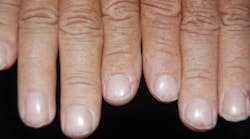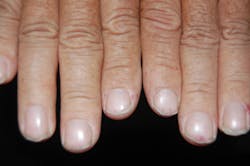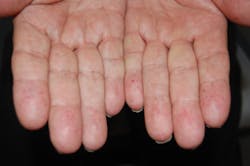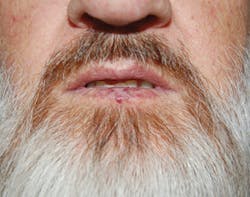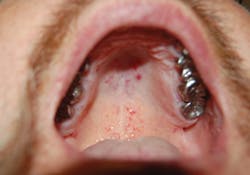Check for HHT before recommending oral irrigating devices
By Valerie Chambers, RDH, BS
Recently my daughter-in-law was diagnosed with a mysterious life threatening disease. As I researched this disease, I discovered this is a condition that has the potential to be initially screened in dental offices.The purpose of this article is to brief dental hygienists on significant symptoms easily visible during oral cancer exams and how to quiz patients regarding an additional symptom that may or may not be directly asked on the medical history questionnaires, which can link patients to this disease entity.
The medical history questionnaire used in my dental office is fairly standardized, and for a statement regarding bleeding problems it simply asks if there are any “bleeding disorders.” How many hygienists ask a patient about nosebleeds when the patient gives a positive response to bleeding disorders? Or how many hygienists ask about a family history of nosebleeds, or examine the frequency, spontaneity, or duration of nosebleeds? I admit I was negligent and uninformed about the severity of this symptom. Now I realize it can be a direct link to a hemorrhagic disease called hereditary hemorrhagic telangiectasia, or HHT. Recognizing this symptom in the dental office can be an important diagnostic tool and can mean the difference between life and death to a segment of our population, including children.
One in 5,000 people are diagnosed with HHT, a genetic disorder that causes abnormalities of blood vessels. Most blood vessels in the body of patients with HHT are normal. However, there is a specific type of abnormality present in a small percentage of these vessels that creates vascular changes. These abnormal vascular structures range from dilated micro vessels (telangiectasias, pronounced tel-AN-jee-eck-taze-ee-ya) to large arteriovenous malformations (AVMs). Telangiectasias can be an important visual symptom of this disease, and are seen as small cherry red dots on the tongue, palate, lips, fingers, toes, and conjunctiva of the eye, and these are areas readily visible to dental hygienists. It is reported that 90% of HHT patients exhibit these mucotaneous talangiectasia symptoms in their mouths and on their hands (see photos.)
Telangiectasias are also present in the nose of 90% of HHT patients and are often the first sign of HHT, as nosebleeds can occur spontaneously, profusely, and regularly. Sometimes hospitalization is required to control the bleeding. This symptom greatly alters the lifestyle of 15% of these patients by limiting their activities. Remember, children often experience nosebleeds, and while there are multiple reasons for nosebleeds in children, there is a strong genetic profile associated with HHT, and often HHT is not diagnosed for years because the symptoms and genetic profile are not connected.
Large altered vascular structures often appear as pulmonary arteriovenous malformations (PAVMs), occur in 30% to 40% of these patients, and present the greatest risk to the dental patient. As dental hygienists are aware, the most common route for entry of bacteria into the bloodstream is from the gingiva, and these abnormal connections can allow bacteria to pass into the systemic circulation. Once in the system, bacteria can seed in the brain and cause abscesses. Any patient with a positive bubble study or PAVM should be treated with prophylactic antibiotics as recommended by the American Heart Association guidelines.
Other risks associated with PAVMs are hypoxia, pulmonary hemorrhage, and cerebral embolism. Stroke occurs in 30% of these patients. Dental professionals should be aware of these complications in these patients, and elevating the dental chair to a vertical position is recommended during dental treatment, as is being prepared with oxygen when treating HHT patients with PAVMs. CT scans and MRIs can detect these malformations.
Gastrointestinal bleeding due to AVMs is common in 20% to 30% of this population after age 40. If HHT is suspected, anti-inflammatory over-the-counter medications such as Motrin, aspirin, Advil, Naprosyn, or Aleve can increase gastrointestinal bleeding and should not be recommended for postoperative therapy.
HHT is a rare genetic disease typically passed down from a parent who has the gene. Siblings often share this diagnosis. Dental professionals may be the key to diagnosing this disease for many patients because oral lesions may be the first sign of the disease. Knowledge of the symptoms and problems associated with this disease and treatment in the dental office should be altered to accommodate those with the disease. If you suspect an HHT diagnosis, proceed with caution.
Telangiectasias can vary from pinpoint sized to pea sized and can bleed with slight trauma. Any normal dental procedure, such as scaling and polishing, can be hazardous. Be watchful and prudent in your care. Recommend oral irrigating devices carefully as they
too can also create bacteremia. Treat patients with a prophylactic antibiotic regimen according to the American Heart Association guidelines before starting dental treatment, and until the patient is screened and proven not to have complications of this disease.
Final note: The day this article was submitted to RDH magazine, a patient presented in the dental office where the author works as a dental hygienist. Two of the criteria for HHT were observed. The patient was referred to Dr. McWilliams for an evaluation. RDH
Valerie Chambers, RDH, BS, practices in a general dentistry office in rural northern California. This is her third contribution to RDH magazine. She thrives on connecting with patients, enjoys temp positions, and volunteers at her local hospice organization.
References
1. Da Silva Santos PS, Fernandes KS, Magalhaes MH. “Osler-Weber-Rendu Syndrome-Dental Implications.” JCDA www.cda-adc.ca/jcda September 2009, Vol.75(7): 527-529.
2. Christensen GJ. “Nosebleeds May Mean Something Much More Serious: An Introduction to HHT.” Journal of the American Dental Association, Vol. 129, May 1998. p. 635-637.
3. Guttmacher AE. “Medical Summary Hereditary Hemmorhagic Telangiectasia Summary for Physicians and Health Care Providers.” http://hht.org/medical-scientific/medical/summary
4. Guttmacher AE. “Dental Care.” http://hht.org/living-with-hht/dental-care/
Sincere appreciation for editorial assistance and photographs given to: Justin McWilliams, MD, Assistant Professor, Division of Interventional Radiology, David Geffen School of Medicine at UCLA.
The diagnostic criteria for HHT include:
1. Nosebleeds (epistaxis): spontaneous, profuse, and recurring with regularity
2. Telangiectasias: characteristic sites include face, lips, palate, fingers, eyes, and toes
3. Arteriovenous malformations: pulmonary, cerebral, hepatic, spinal, or gastrointestinal
4. Family history: a first-degree relative with HHT according to these criteria.
The clinical diagnosis of HHT is considered:
- Definite when three or more criteria are present
- Possible or suspected when two of the criteria are present
- Unlikely when fewer than two of the criteria are present
Because of the rarity of this disease and the need for coordinated treatment among specialists of different organ systems, the HHT Foundation has established 12 Centers of Excellence for HHT treatment in the U.S. and two in Canada. The Center for Excellence at UCLA includes 10 different subspecialties and offers coordinated care for HHT. Care begins with a call and a clinical evaluation. Encourage patients to contact UCLA at (310) 481-7543 or email questions to [email protected]. Contact www.hht.org for a complete listing of the Centers of Excellence for HHT and to learn about volunteer opportunities in your area.
Past RDH Issues
